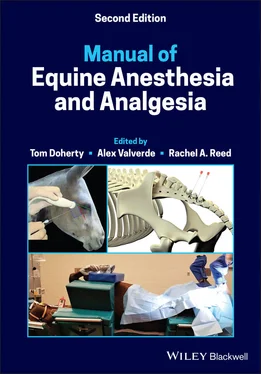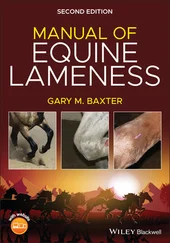See Table 5.1for a summary of the diuretic classes.
Table 5.1 Site and mechanism of action of diuretics.
| Diuretic Class |
Examples |
Site of Action |
Mechanism of Action |
| Osmotic diuretics |
Mannitol |
PCT |
Inhibits Na +and water reabsorption |
| Carbonic anhydrase inhibitors |
Acetazolamide |
PCT |
Inhibits activity of carbonic anhydrase |
| Loop diuretics |
Furosemide |
Thick ascending limb of LOH |
Inhibits Na +‐K +‐Cl −cotransporter |
| Thiazide diuretics |
Hydrochlorothiazide |
DCT |
Inhibits Na +‐Cl −cotransporter |
| Potassium sparing diuretics – Aldosterone inhibitors |
Spironolactone |
Collecting duct |
Inhibits aldosterone receptor |
| Potassium sparing diuretics – Sodium channel blockers |
Amiloride |
DCT |
Inhibits Na +channel |
PCT – Proximal convoluted tubule.
LOH – Loop of Henle.
DCT – Distal convoluted tubule.
A Osmotic diuretics (e.g. mannitol )
Inhibit water and sodium reabsorption predominantly at the PCT with some effects on the descending LOH and collecting duct.
Expand extracellular fluid and plasma volume, increasing RBF.This will lead to medullary washout and an inability to concentrate urine.
They are filtered through the glomerulus and increase osmotic pressure in the tubule. This reduces transmembrane water flow.
Note : glucosuria will also induce an osmotic diuresis.
B Carbonic anhydrase inhibitors (e.g. acetazolamide )
Acetazolamide is highly protein bound and is not filtered by the glomerulus.It is secreted by the proximal tubule.Secretion is GFR dependent.
It inhibits the activity of membrane and cytoplasmic carbonic anhydrase in the PCT, preventing reabsorption of bicarbonate. This results in decreased activity of the Na+/H+ exchanger, causing more sodium to remain in the filtrate.
Increases renal excretion of Na+, K+, HCO3−.
Results in a proximal renal tubular acidosis.
Can cause metabolic acidosis.Hence, its potential use as a treatment for metabolic alkalosis.
Other clinical uses of acetazolamide include glaucoma and neurologic disorders.
In equine practice, their main use is in horses likely to be affected by a hyperkalemic periodic paralysis (HYPP) episode.
Use in potential HYPP episodes : (see HYPP Chapter 38)
Acetazolamide may be administered to horses prone to develop HYPP in order to increase potassium excretion prior to an anesthetic event, for example. It is generally recommended that acetazolamide be administered for a minimum of two days prior to anesthesia.
C Loop diuretics (e.g. furosemide)
Furosemide is the most commonly used diuretic in horses.
Furosemide inhibits the Na+‐K+‐Cl− cotransporter in the luminal membrane of the thick ascending limb of the LOH.It binds specifically and reversibly to the Cl− binding site of the transporter's transmembrane domain.
Because this transporter reabsorbs about 25% of the sodium load, its inhibition by furosemide causes an increase in the distal tubular concentration of sodium, leading to a decrease in water reabsorption in the collecting duct.This inhibits reabsorption of Na+, Cl−, K+, and water.
It blocks the ability of the kidney to develop a counter‐current mechanism, limiting the ability to concentrate or dilute urine.
Furosemide induces renal synthesis of prostaglandins, and this increases RBF and leads to a redistribution of renal cortical blood flow.
Furosemide reduces plasma and extracellular fluid volume resulting in decreased blood pressure and cardiac output.
Its use can lead to volume depletion, azotemia, metabolic alkalosis, and electrolyte abnormalities (hyponatremia, hypokalemia).
The loss of H+ and K+ can be attributed in part to activation of the RAAS secondary to a decrease in blood volume and pressure.Aldosterone causes sodium reabsorption and increases K+ and H+ excretion.
Can potentiate the toxicity of aminoglycosides.
D Thiazide diuretics (e.g. hydrochlorothiazide)
This group of diuretics is rarely used in horses.
Thiazides inhibit the Na+/Cl− cotransporter in the DCT, decreasing sodium reabsorption.
However, this transporter is only responsible for reabsorbing about 5% of the filtered sodium.Thus, thiazides are not as effective as loop diuretics in promoting diuresis and natriuresis.However, like loop diuretics, part of the loss of H+ and K+ is due to activation of the RAAS.This can result in K+ loss leading to hypokalemia.
E Potassium sparing diuretics
Do not promote secretion of K+ into urine.
Have a weak diuretic effect because the sites of action are very distal in the nephron.
Aldosterone inhibitors (e.g. spironolactone)
Block effects of aldosterone on aldosterone‐receptors leading to reduced Na+ reabsorption.
This results in more sodium and water passing into the collecting duct and being excreted.
The potassium sparing results from inhibiting sodium reabsorption which causes less K+ and H+ to be exchanged for Na+, and thus not lost in the urine.
Sodium channel blockers (e.g. amiloride)
Also called “Epithelial Sodium Channel Inhibitors”
They directly inhibit sodium channels in distal tubule, reducing Na+ reabsorption.
Have similar effects to spironolactone on H+ and K+.
VI Nonsteroidal anti‐inflammatory drugs
NSAIDs can affect renal function by a variety of mechanisms.
The effects of NSAIDs on the kidney are more profound during episodes of hypotension and hypovolemia.
The renal effects of NSAIDs are discussed in detail in Chapter 16.
1 Cook, V. and Blikslager, A. (2015). The use of nonsteroidal anti‐inflammatory drugs in critically ill horses. J. Vet. Crit. Care 25: 76–88.
2 Geor, R. (2007). Acute renal failure in horses. Vet. Clin. North Am. Equine Pract. 23: 577–591.
3 Toribio, R. (2007). Essentials of equine renal and urinary tract physiology. Vet. Clin. North Am. Equine Pract. 23: 533–561.
6 Neurophysiology and Neuroanesthesia
Tanya Duke‐Novakovski
Anesthesia for horses with intracranial pathology is not common, but anesthesia for horses with head trauma might be required.
An understanding of the effects of anesthetic drugs on intracranial pathophysiologic processes is useful in the event that general anesthesia may be required.
Horses with seizures may have to be anesthetized for diagnostic procedures or for control of seizures.
I Neurophysiology
Membrane potentials
Nerve cell membrane potentials are maintained through differential distribution of ions across the membrane.
Depolarization causes movement of sodium and potassium ions, which depolarizes the next segment of the nerve cell. This allows transmission of impulses along nerve axons.
Junctions between nerve cells allow nerve transmission to take multiple pathways.
Excitatory or inhibitory neurotransmitters are released into the synaptic cleft to activate receptor sites on the post‐synaptic cell.
Excitatory neurotransmitters in the CNS include acetylcholine, norepinephrine, dopamine, 5‐hydroxytrytamine, substance P, glutamate, and other amino acids.
Читать дальше












